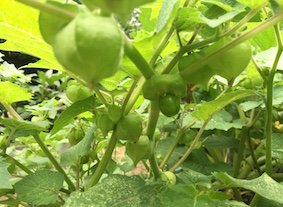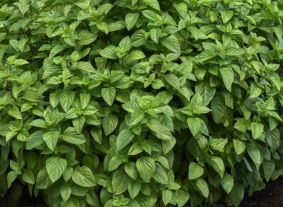Growing Tomatillos in the Home Vegetable Garden
Views: 6268

This summer I am maintaining a few vegetable garden beds at a human services facility that I did not plant. The staff at the facility enjoys watering and harvesting as it’s a relaxing thing for both staff and clients to do. But when it comes to the maintenance of the garden, they were a little over their heads. I was called in to assess and help maintain the beds in July. Things looked great! They had planted leftover vegetable transplants donated from a plant sale earlier in spring, so had ended up with a few items of this and that. Tomatoes, acorn squash, Chinese eggplant, cucumbers, chard, peppers, zucchini … and tomatillos.
I’ve never grown tomatillos, also known as husk cherries or husk tomatoes. However, I do know what they are—it’s a relative of the tomato in the Physalis genus. The fruit has a paper-like covering that reveals a green, yellow or purplish (depending on variety) sweet to tangy smallish fruit when ripe. It’s often used in Mexican cooking. My only experience with them thus far (except as a salsa verde at Mexican restaurant) was a warning from a community garden member a few years ago. “Watch out, Heidi is growing tomatillos; the birds will spread them all over the garden and we’ll be overrun with them next year.” Sadly, yes, that has been my one exposure to them.
My Research
I’ve left the tomatillos pretty much alone over the last month. I’ve done some research, though, and here’s what I’ve learned thus far.
—To produce fruit you will need to plant two tomatillo plants near each other as the plants are “self sterile”. i.e. a plant cannot pollinate itself.
—Just like tomatoes, plant tomatillos in a sunny location once the danger of frost has passed. Water evenly and deeply.
—Also just like tomatoes, tomatillos benefit from trellising or staking, lifting the plant and its fruit off the ground. This encourages air circulation to prevent disease. (We haven’t trellised in this garden. But thanks to dry, hot weather everything is okay so far!)
—Tomatillos are ripe with they fill out the diameter of the papery husk. They should still remain a vibrant green hue. Even varieties of different colors are best used on the green side for cooking as they are less tart and firm.
—As for pests, nothing has yet encumbered our tomatillos. However, I have read flea beetles are attracted to the leaves. As for biting or chewing insects (and critters), the papery husks go a long way to protect them. Birds like them, too, by the way.
The tomatillo pictured above is still quite small but has somehow shimmied its way out of its husk. These fruits have a ways to go before they are ready to pick. Looking forward to partaking in the first harvest!
Meet Ellen Wells
When you’re raised on a farm, you can’t help but know a thing or two about gardening. Ellen Wells is our expert on edible gardening.…
Ellen's Recent Posts

Everleaf Lemon Basil






